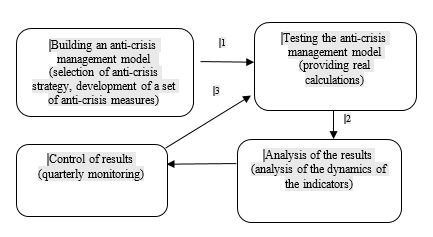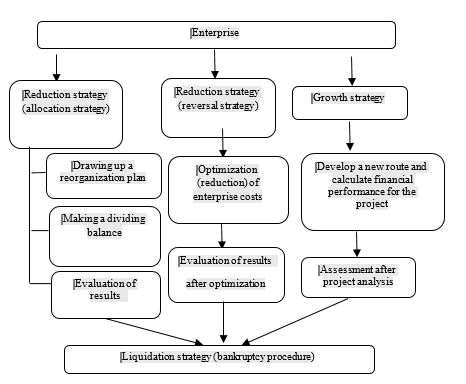Abstract
The aim of the research is to create and develop an improved model of crisis management in enterprises: implementation of its anti-crisis strategies, implementation of anti-crisis management measures and analysis of the result. The need to build and implement a common crisis management model for enterprises has been identified and substantiated. Strategies of crisis management within the framework of the creation of a set of anti-crisis measures have been developed and implemented: alternative options for the company have been considered. As part of the allocation strategy, it will be necessary to build a dividing balance between the two enterprises: the enterprise, which will continue to operate and the second will leave most of the obligation on loans and in the future will be liquidated or go bankrupt. The financial indicators will be calculated before and after and the results will be evaluated. As part of the reversal strategy, the main items of production costs will be analyzed, financial indicators will be calculated and the results will be evaluated. As part of the implementation of the growth strategy, the profitability of the new project will be calculated and the company financial position will be analyzed. In the case of the liquidation strategy the liquidation cost of the enterprise will be calculated. If a negative effect of the proposed strategies is obtained as a result of monitoring, this model will be sent for re-development, further testing, additional study of the components of the model to obtain a positive result.
Keywords: Bankruptcycrisis forecastingcrisis managementcrisis management modelfinancial conditionstrategy
Introduction
Currently, an increase in the number of failed enterprises due to the global crisis affecting our country is observed in the Russian Federation. The main cause of crises in enterprises is changes in the external environment. Changes in the external environment contribute to the creation and implementation of new improved anti-crisis complex for the enterprise. In this regard, the development of crisis management systems as a mechanism for preventing crisis situations is relevant for modern enterprises (Rogova, 2017).
This study is dedicated to improving the management model of the company in the times of crisis. The study is based on initial data for enterprises.
The aim of the study is to create and develop an improved model of crisis management in enterprises: implementation of its anti-crisis strategies, implementation of anti-crisis management measures and analysis of the results.
In accordance with the purpose of the study, the following tasks are highlighted:
а) building a common crisis management model for the enterprise;
b) implementation of crisis management strategies to prevent a crisis situation in the enterprise;
c) analysis of the results of crisis management of enterprises.
The object of the study is a company on the verge of bankruptcy.
The subject of the study is anti-crisis management that acts as the main tool to overcome the crisis of the enterprise
The information base is: regulations, methods, instructions, official financial statements of enterprises, management accounting data on the enterprise, statistics, articles, Internet sources.
Problem Statement
Having analyzed modern foreign approaches and studied the information base of the crisis management we can conclude that anti-crisis management in Russia is a topical topic for modern entrepreneurs. Many enterprises, entering the crisis stage, have no idea where to start and how to develop the right anti-crisis strategy. Having reviewed and studied modern scientific sources on this topic, it seems that scientists offer separate measures and measures as an opportunity to avoid a crisis situation (Filippova & Kepp, 2017).
The problem of crisis management in Russia is the lack of a comprehensive algorithm of measures in case of a crisis situation at the enterprise.
In this regard, within the framework of the study, the main goal will be to develop a step-by-step algorithm of actions in case of a crisis situation and its practical application at the enterprise.
In recent years, a new area of activity has emerged - crisis management (Bulava, Mingaliev, & Shamsutdinova, 2019). In this regard, the labor market can meet such a specialist as an anti-crisis manager who is able to carefully analyze the entire business, identify its pros and cons and develop a list of actions that will allow an owner to overcome crisis phenomena with the least losses (Feinschmidt, 2016).
Research Questions
How to create a common crisis management model for Russian enterprises?
What anti-crisis strategies should be applied to achieve the result?
Purpose of the Study
The aim of the study is to create and develop an improved model of crisis management in enterprises: implementation of its anti-crisis strategies, implementation of anti-crisis management measures and analysis of the results.
Research Methods
The crisis management within the framework of this study will be divided into stages, each will include a set of anti-crisis measures.
Figure

Each step needs to be considered in more detail. The first stage is to build up a model of crisis management. The main component of this stage is the development of an anti-crisis strategy. An anti-crisis strategy is a development plan for an organization whose goal is to achieve a rapid exit from the unstable state such as time and speed - the main factors of the organization when the organization exits from the crisis state (Palkina, 2018).
The construction of the anti-crisis management model for the enterprise will consist of 3 components depending on the chosen anti-crisis strategy (Bunkovsky, 2019).
The company can use the reorganization procedure as an anti-crisis measure through the allocation procedure to improve the financial condition. This is a reduction strategy.
Also, the company in order to improve its financial situation can optimize its costs by reducing them. This procedure also applies to a reduction strategy, namely a reversal strategy.
If it is not possible to improve the financial situation through anti-crisis measures, bankruptcy proceedings will have to be resorted to. This procedure is part of the liquidation strategy.
Figure

The second stage of crisis management is the testing of this model as a part of the calculations with the company data. The third stage is to evaluate the results after the implementation of the strategies.
As part of the allocation strategy, it will be necessary to build a dividing balance between the two enterprises: the enterprise, which will continue to operate and the second will leave most of the obligation on loans and in the future will be liquidated or go bankrupt. The financial indicators will be calculated before and after and the results will be evaluated.
As part of the implementation of the reversal strategy, the main cost items of the enterprise will be analyzed, inflated costs will be reduced, financial indicators are calculated and the results will be evaluated.
As part of the implementation of the growth strategy, the profitability of the new project will be calculated and the company financial position will be analyzed. When considering the liquidation strategy, the liquidation value of the enterprise will be calculated.
If the proposed strategies are adversely affected by the monitoring, the model will be re-developed and further tested.
Findings
As a part of this study, the company anti-crisis management strategies were reviewed and analyzed. Table
Having analyzed and considered the implementation of each strategy of crisis management for the enterprise, we can conclude that in order to achieve a positive result in a crisis, it is necessary to do everything necessary in the shortest possible time action to bring the company out of the crisis (Bintang, 2017). To do this, within the framework of the overall model of management of the enterprise in a crisis, the implementation of all of the above strategies is the key to success and the future for the enterprise. Working on the possibility of creating a new project, optimizing existing costs, the possibility of reorganization, as well as the bankruptcy procedure, the company still has a better chance of survival. In each strategy, you can find something necessary for a particular enterprise and implement to improve its economic condition.
This study presents a possible algorithm of actions for the Russian enterprise in difficult conditions as today small and medium-sized enterprises do not know what to do in case of crisis situations, there is no qualified personnel in this field. The presented general model of crisis management is an effective algorithm of the behavior of the Russian enterprise in crisis conditions that can be guided and implemented.
Conclusion
As part of this study, a comprehensive model of the management of the enterprise in crisis situations was developed, which is aimed at building a common algorithm of the company actions in case of crisis situations. The components included in this model are considered, the advantages and disadvantages of each of the proposed components are analyzed, conclusions are drawn about the need to use and incorporate into the complex model of each component to overcome crisis situations as well as to improve the financial condition of the enterprise.
References
- Bulava, I. V., Mingaliev, K. N., & Shamsutdinova, E. R. (2019). Integrated Risk Management Model of The Company. The European Proceedings of Social and Behavioural Sciences, 57, 137-147. DOI:
- Bunkovsky, V. I. (2019). Building a Modern Financial Model of Company Management. Advances in Social Science, Education and Humanities Research, 333, 822-826. DOI:
- Bintang, A. S. (2017). Image management model in company crisis. Komuniti: Jurnal Komunikasi dan Teknologi Informasi, 8(1), 35-40. DOI:
- Feinschmidt, E. A. (2016). Foreign anti-crisis management practice. Moscow: The Eurasian Open Institute.
- Filippova, A. A., & Kepp N. V. (2017). Analysis of modern foreign approaches to crisis management. A collection of materials from the scientific conference “Science Week 2017” (pp. 322-325). St. Petersburg: St. Petersburg Polytechnic University Publishing House. [in Russ.].
- Filippova, A. A., & Smirnova, O. A. (2018a). Analysis of the relationship between the bankruptcy of major Russian airlines and the emergence of low-cost carriers. A collection of materials from the science conference “Science Week 2018”, (pp. 226-228). St. Petersburg: St. Petersburg Polytechnic University Publishing House. [in Russ.].
- Filippova, A. A., & Smirnova, O. A. (2018b). Comparison of bankruptcy procedures and investor search for companies in the digital economy. In A. V. Babkin (Ed.) Digital Economy of Industry and Services: State and Trends of Development: Proceeding of XVI Scientific and Practical Conference with International Participation, (pp. 388-394). St. Petersburg: POLITECH-PRESS. [in Russ.].
- Palkina, E. S. (2018). Using business process improvement concept to optimize enterprise production system in conditions of innovative economic development. In A. Vorozhtsov (Ed.) International Conference on Modern Trends in Manufacturing Technologies and Equipment (ICMTMTE 2018), 02011. Les Ulis Cedex, France: EDP Sciences. DOI:
- Rogova, T. N. (2017). Crisis management of the enterprise: a training manual. Russian Federation, Ulyanovsk: ULSTU.
Copyright information

This work is licensed under a Creative Commons Attribution-NonCommercial-NoDerivatives 4.0 International License.
About this article
Publication Date
31 December 2019
Article Doi
eBook ISBN
978-1-80296-076-1
Publisher
Future Academy
Volume
77
Print ISBN (optional)
-
Edition Number
1st Edition
Pages
1-1056
Subjects
Industry, industrial studies, project management, sustainability, business, innovation
Cite this article as:
Chelak, S. V., & Smirnova*, O. A. (2019). Development Of A General Model Of Enterprise Management In Crisis. In I. O. Petrovna (Ed.), Project Management in the Regions of Russia, vol 77. European Proceedings of Social and Behavioural Sciences (pp. 996-1001). Future Academy. https://doi.org/10.15405/epsbs.2019.12.05.122
